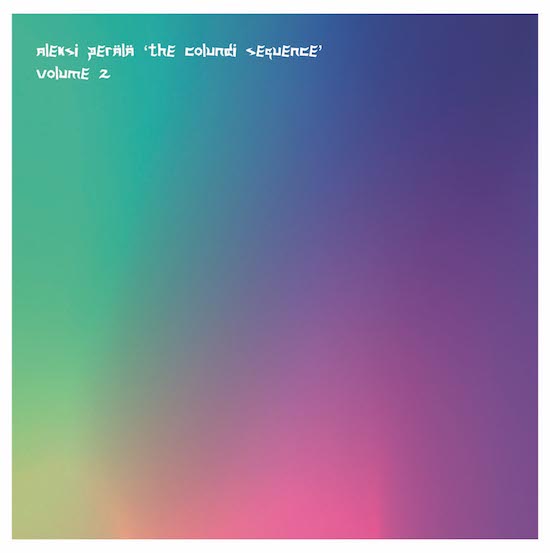Aleksi Perälä’s Colundi Sequence Volume 1 wasn’t just one of the most weirdly beautiful releases of last year, it was also the album that stuck with me most – home to 18 tracks that I kept on going back to as if I couldn’t quite understand what was going on.
On a prosaic level, maybe this was to be expected of an album that featured tracks with titles like ‘UK74R1512110’, ‘GBBVT1337152’ and – who could forget? – ‘UK74R1517050’: there was very little in logical, linguistic terms for the brain to cling to. But the real enigma of the album was the way in which the music was made. The Colundi Sequence on which the album was based refers to scales devised by Perälä and former Rephlex boss Grant Wilson-Claridge, based on 128 resonant frequencies “chosen via experimentation and philosophy, each relating to a specific human bio-resonance, or psychology, traditional mysticism or belief, physics, astronomy, maths, chemistry.”
The “standard” Western musical thinking of a keyboard divided into octaves with semitones was out, in other words, replaced by microtonal pitches that obeyed the internal logic of Colundi. As a result, the melodies on Colundi Sequence Volume 1 sounded both alien and beautiful, an otherworldly musical feast that was inscrutable in its charm. There was something gorgeously confounding in the album, which refused easy explanation and invited repeat listening.
That makes The Colundi Sequence Volume 2, released just eight months after the preceding volume, both extremely welcome and strangely overwhelming.
Welcome, because it might just be my only chance of getting to grips with the avalanche of Colundi material that Perälä has recorded – Volume 1 was compiled from 16 Colundi “Levels”, with the Finnish producer releasing two more Colundi albums in the intervening months – and overwhelming because I feel so far from exhausting the charms of Volume 1.
The majority of the 16 tracks on Volume 2 will be recognisable to fans of Volume 1 thanks to the base of outlandish melody, which rings through the album clear as a lunar bell. But the two volumes differ significantly in terms of pace and energy. Volume 1 was, according to Clone, a work of techno, “music that excels in a dark, smokey and isolated basement”. It was intriguing, unsettling even, but there as enough oomph in the drums to make it danceable.
Volume 2, however, rounds up the more ambient side of Perälä’s Colundi work. Of the 16 tracks here, eight feature no drums at all and a good half of these are so minimal in overall feel they barely even exist. Track eight – ‘UK74R140202’ – for example, spends its first minute in near silence, only to be interrupted by the slow hum of a single synth note and some Pole-esque pops and crackles, which hang around in splendid cosmic isolation.
Elsewhere, as on the brilliant ‘UK74R1406070’, the microtonal melody of Volume 1 returns in force but freed from the pulsing four four kick that played a prominent role on the previous album. The effect, rather beautifully, is to highlight Perälä’s compositional skills, with the melody pushed to the forefront of echoing production vacuums. Here, even more so than on Volume 1, Aphex Twin’s Selected Ambient Works 2 is a point of reference. But whereas Richard D. James’ masterwork sounded downright grotty at times, Perälä’s melodies shine as if bathed in light from a far-off planet.
Space plays a major role on Volume 2. The tracks here sound expansive, grandiose even; operating in their own universe of echo and reverb, and even when the drums do appear – as on ‘GBBVT1337202’ – they sound less like invitations to dance and more like monoliths marking an astral path, an effect similar to the sparse, echoing 808s on early Plastikman records like ‘Plasticity’. But perhaps Volume 2’s most surprising dimension is revealed on three tracks, ’UK74R1514020’, ‘UK74R1512020’ and ‘UK74R1515050’, which bring what sounds like – but almost certainly isn’t – live, acoustic instruments into the mix.
‘UK74R1512020’ features a gorgeous detuned piano melody, the kind of thing a vaguely benevolent ghost would knock up on a dusty grand piano mid way through a better class of horror film; ‘UK74R1515050’ combines metallic synths with what sounds like someone playing the Stone Roses’ ‘Fools Gold’ on a children’s drum kit; and best of all is ’UK74R1514020’, which combines the sound of piano, harp, steel drum and cymbal, all microtuned to a tone that would presumably exclude an actual acoustic performance. Hearing the Colundi scales transported to ostensibly “real” instruments makes them sound even more magical, like the work of some impossible acoustic sorcerer rather than a bloke from Finland.
For fans of Volume 1, this new compilation won’t have quite the shame shock of the new. But that should take nothing away from what it is: another extraordinary, brilliant record – one that demonstrates a new flexibility to the Colundi sound (at least for the casual observer). Pure musical escapism might be a dangerous thing in 2017’s rotten geopolitical environment. But, Christ, Aleksi Perälä makes it feel attractive here.


